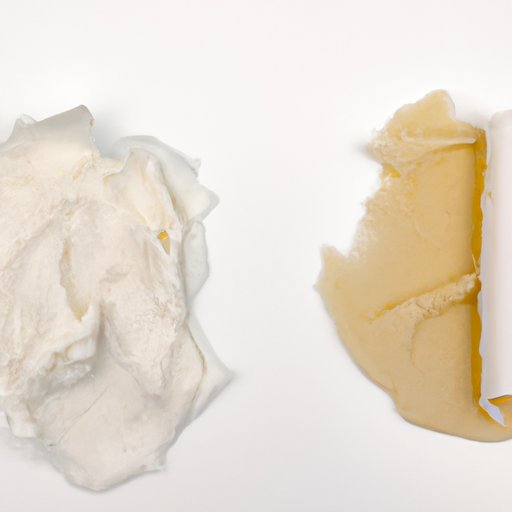
Introduction
Sticky residue can be quite frustrating to deal with, whether it’s on a window, a plastic surface, or even fabric. It can accumulate due to various reasons, including adhesive products, food residues, and many more. Sticky residue can be challenging to remove effectively, and this article aims to provide the ultimate guide to removing it. Knowing how to remove sticky residue is essential, and this article offers a comprehensive approach to achieve just that.
Using Household Products to Remove Sticky Residue
Household products are a popular choice for removing sticky residue, and they’re often readily available. Three household products that are effective in removing sticky residue include vinegar, baking soda, and rubbing alcohol.
Vinegar is a mild acid that can break down and dissolve sticky residue. To use vinegar to remove sticky residues, mix equal parts water and vinegar, apply the solution on the affected surface, and let it sit for a few minutes. Later, scrub the surface with a clean cloth or sponge.
Baking soda is another popular household product that can be used to remove sticky residue. Create a paste of equal parts baking soda and water, apply it to the affected area, and let it sit for a few minutes. Use a damp sponge to scrub the surface, and then wipe it clean.
For stubborn sticky residues, rubbing alcohol is an excellent choice. Rubbing alcohol can dissolve the residue and remove the stickiness. Apply rubbing alcohol directly on the residue, scrub with a clean cloth, and rinse with water.
Although these household products are effective, they also have their pros and cons. They require effort and time to work, and they may not always work on every surface or residue type.
Using Adhesive Remover Products
Adhesive remover products are specifically designed to remove sticky residue from a wide range of surfaces. Different types of adhesive remover products are available for purchase, and they all work differently based on the specific product used.
Adhesive removers are useful when dealing with stubborn adhesives or residues that may not respond to household products. It’s important to take precautions when using these products and follow the instructions carefully to avoid damage to the surface.
The benefits of adhesive removers include their efficiency and effectiveness, especially when dealing with difficult residue types and surfaces. However, adhesive removers can be harmful to the skin and lungs if misused, and they can also be expensive.
Removing Sticky Residue from Different Surfaces
Sticky residue can affect a wide range of surfaces such as glass, plastic, and fabric. Effective removal methods depend on the surface type and residue type.
To remove sticky residue from glass surfaces, spray the surface with an ammonia-based window cleaner and wipe with a clean cloth. For plastic surfaces, use household products or adhesive removers, and scrub with a sponge or cloth. Fabric surfaces may require specialized residue removers, and it’s essential to read the care instructions to avoid damaging the material.
While removing sticky residue from surfaces, it’s crucial to be aware of the pros and cons of each method. Some methods may be harsh and cause damage to the material or surface, while others may require repeated attempts to remove the residue successfully.
Natural and Eco-Friendly Alternatives
Natural and eco-friendly alternatives to removing sticky residue are becoming popular due to their effectiveness and safety. Coconut oil and lemon juice are natural options that work well in removing sticky residue.
To remove stickiness with coconut oil, apply a small amount on the residue and let it sit for some time. Later, use a clean cloth or sponge to scrub the residue away. Lemon juice is also effective in removing residue, and one can apply fresh lemon juice on the affected area and scrub with a sponge.
The advantages of natural and eco-friendly alternatives include safety and effectiveness. However, they may not be as potent as other methods, and they may also require more time to work.
Tips on Preventing Sticky Residue Build-Up
Preventing sticky residue from building up in the first place is a useful approach. Changing cleaning habits and choosing less sticky products are proactive and preventive measures that can be taken.
Cleaning surfaces regularly and using non-toxic cleaning products can help prevent sticky residue build-up. Additionally, choosing products that don’t typically leave a sticky residue behind, such as water-based adhesives or non-sticky wrapping materials, can also be helpful.
While these prevention tips have their pros and cons, they’re an essential consideration when dealing with sticky residue.
Hacks and Tricks for Removal
Some hacks and tricks can ease the process of sticky residue removal. For example, using a hairdryer on low to soften adhesive before scrubbing, or using white vinegar mixed with baking soda to create a cleaning paste.
Other useful tricks include using duct tape to remove small remnants of stickiness, or using a lint roller to remove residue from fabric surfaces.
Conclusion
Removing sticky residue is essential to maintain the cleanliness and attractiveness of surfaces. This comprehensive guide aims to provide various options for removing sticky residue, including household products, adhesive removers, and natural alternatives. Each method has its benefits and drawbacks, and readers can choose the preferable approach or involve a combination of methods. Additionally, some tips on preventing sticky residue build-up, and some hacks for easy removal were included.
Our final tips for sticky residue removal are to be patient, read the instructions carefully, and test the cleaning solution on a small area before applying it to the whole surface.




